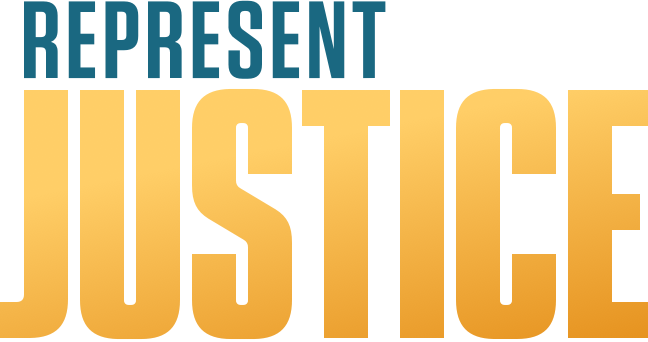Coming home during a pandemic: How Robert E. Lacey overcame hurdles in his reentry journey
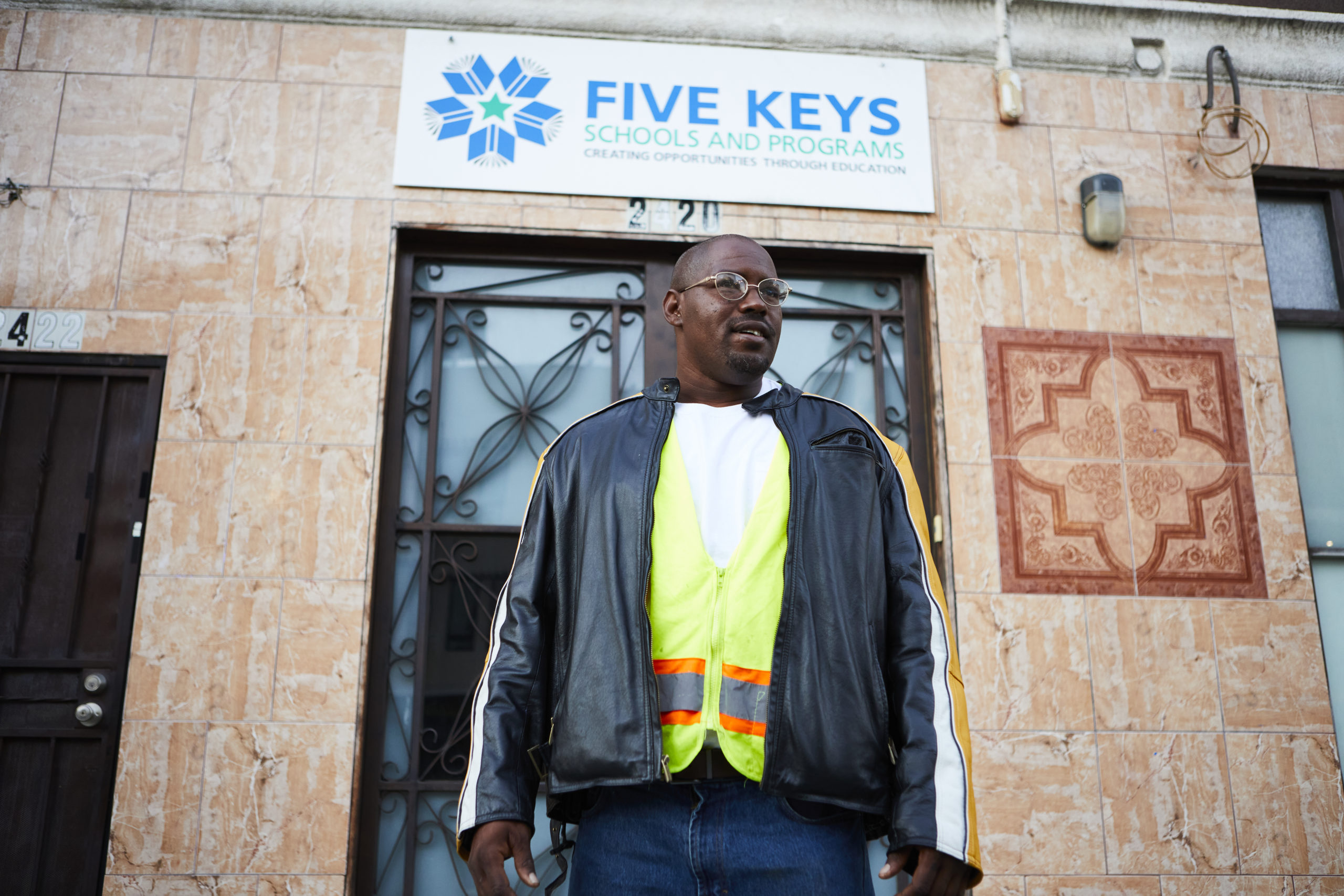
Most days of the week, Robert E. Lacey is an early riser. He wakes up at 4 a.m. and departs the transitional home where he’s living in the San Fernando Valley to make his way into Downtown Los Angeles to start his work day as a Caltrans employee. The days go by quickly, because once he’s home Robert’s evenings are full of zoom meetings and catching up with loved ones.
It’s been a whirlwind of a year for Robert, who was released from Folsom State Prison in October 2020 in the throes of a COVID-19 pandemic that was moving through jails and prisons at a rapid speed. More than 388,000 incarcerated people contracted COVID to date, and at least 2,747 people have died from the virus while incarcerated.
But more than a year after the COVID-19 pandemic took hold, the toll it has taken on the system-impacted community continues to reverberate. And for returning residents who have been released over the last year, the pandemic has made life after prison much harder.
Even without a global pandemic, the stigma that formerly incarcerated people face creates sizable barriers when it comes to getting a job, finding a place to live, food security, healthcare and finding community support. But this year has compounded those challenges, and making it exceedingly difficult to access even the most basic resources, like getting identification or a driver’s license.
Robert has been navigating these challenges since his release, and has spent the last several months settling into life in Los Angeles County. Despite the hurdles, he says it’s been the support of his community that has helped him navigate the reentry process.
Represent Justice followed Robert along one day in April to get a sense of how he’s been managing his reentry journey during these unprecedented times.
“Everything I do is the first time I’ve done it, so having their support and help is wonderful,” Robert said. Its support that has come from friends as well as organizations like the Anti-Recidivism Coalition and Five Keys — through which Robert got his job — that has helped carry him through.
“I think we have a better chance at rehabilitating people coming out of prison, like myself, and institutions and jails. I think that’s the biggest need.”
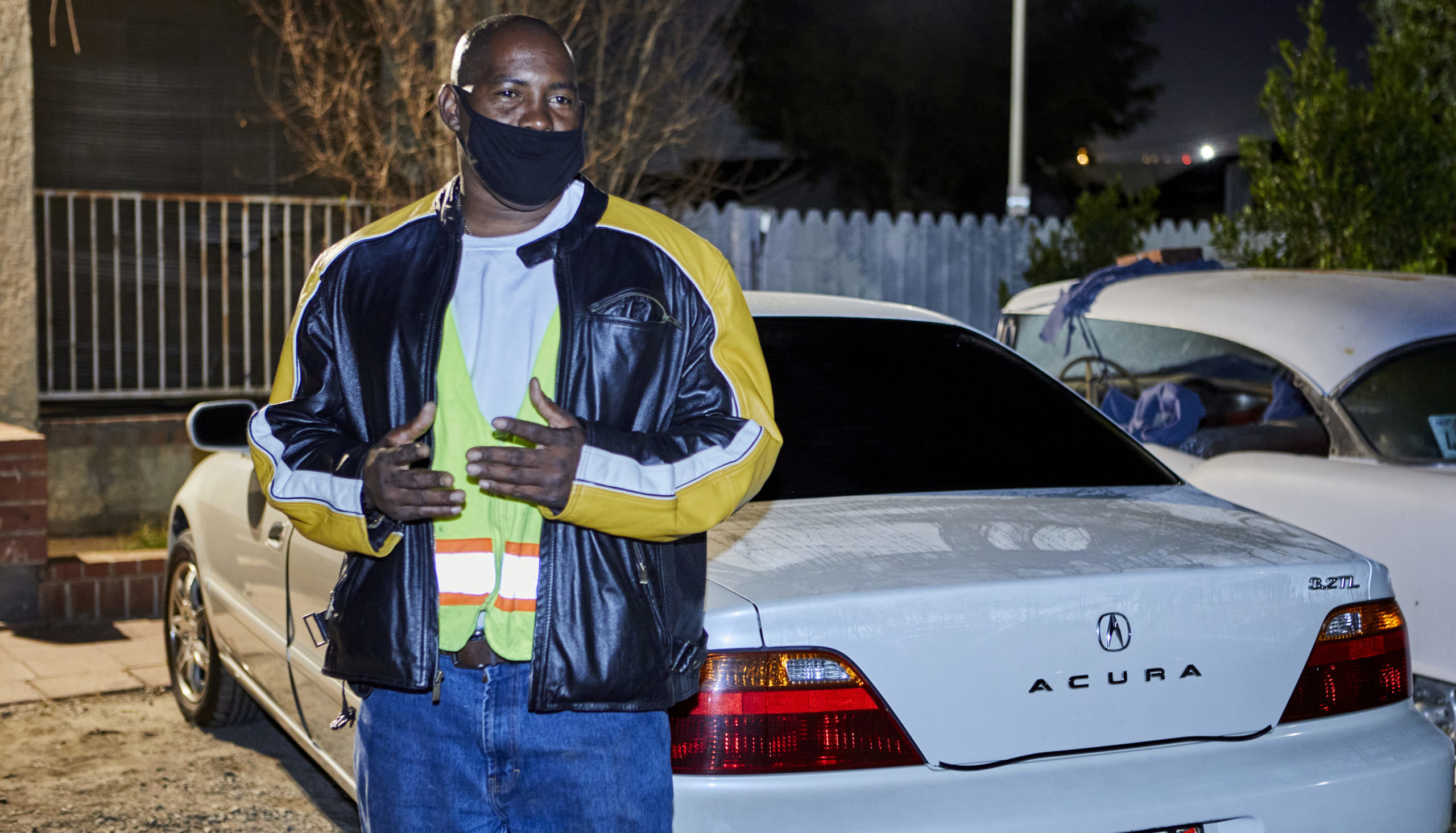
Robert E. Lacey leaves his home in the San Fernando Valley before sunrise to make it into downtown Los Angeles by 7 a.m. He stands next to his white Acura, which he uses to get to and from work. Photo by Nathalie Gordon.
Represent Justice: COVID has changed so many aspects of our worlds, and it’s especially had an impact on folks going through the reentry process. What has this been like for you, and what was your first day home like?
Robert: I was released October 2020. And that day I was released, processing everything was really overwhelming. The ride on the freeway was six hours. And my head felt like it wanted to explode when the car finally stopped and I had the opportunity to kind of get settled a little bit — I hadn’t been traveling that rate of speed. For so long, my body was kind of like in shock, it was all new. My eyes were hurting from, like seeing so much on the side of the road, people and things like that. It took me a while to decompress and [accept] this is really happening. You’re out here released.
With all the COVID stuff going on, it was a little scary, everybody is wearing masks. It’s like, I’ve entered the movies.. “The Matrix,” right? The processing of information was just a little overwhelming, at times causing a little anxiety. I used a lot of my coping skills to deal with that kind of count backwards. You know, believe in trusting God and three C’s — I didn’t cause this, I didn’t create this, But I have to cure this.
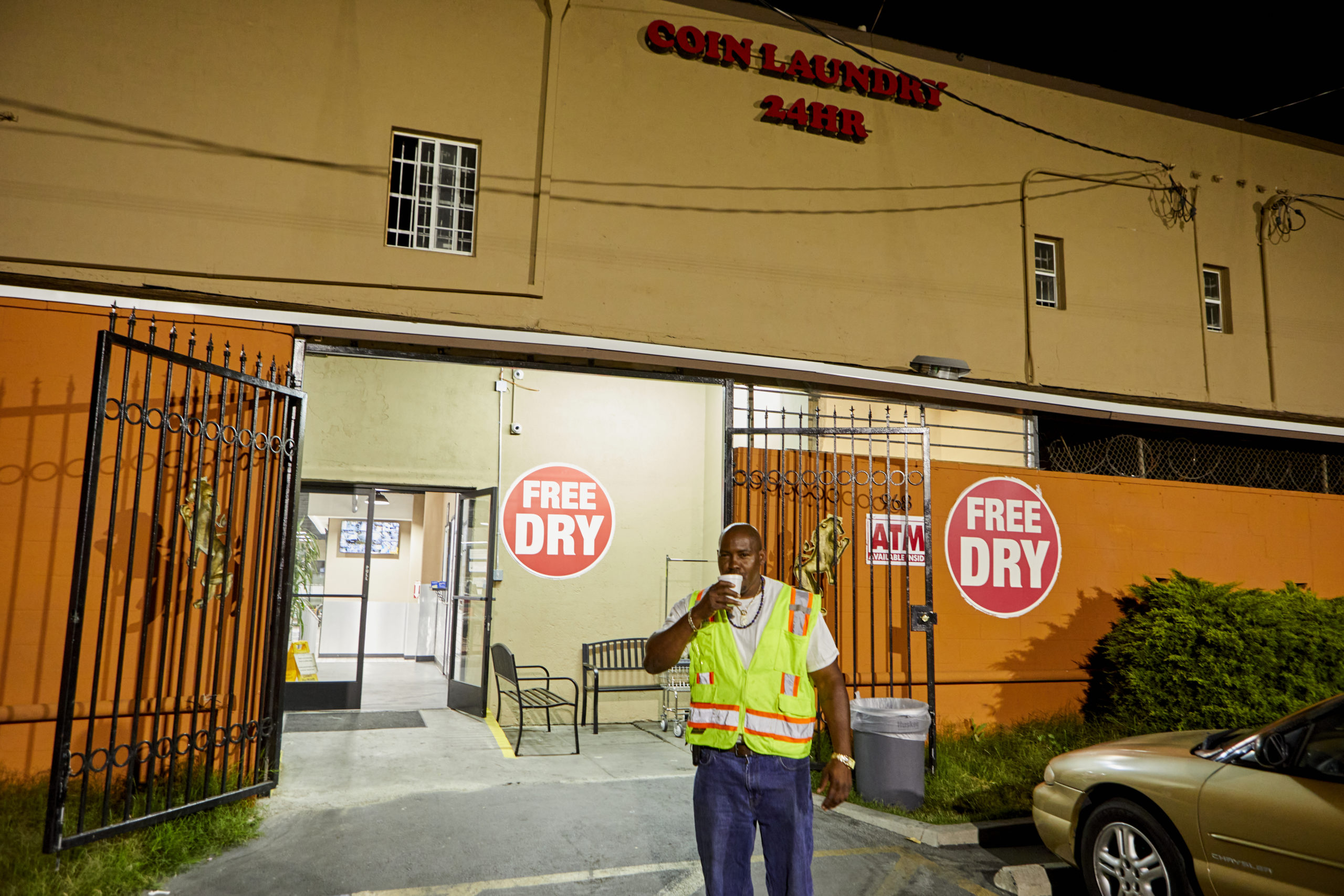
But before Robert heads into work, he grabs a coffee at the laundromat across the street from his home. Photo by Nathalie Gordon.
RJ: I know COVID has impacted some of the ways you’re readjusting, and the space you’re living in now has pretty strict protocols in terms of health and safety, but are there other ways you feel the pandemic has impacted your reentry process?
Robert: I was approved for an overnight family visit with my family, and I still have not had that as of today. But it’s not just me. It’s the COVID restrictions that were placed on California by Governor Gavin Newsom, and in doing so, affected many programs. They’re not allowing us lifers to do overnight visits with family members and stuff like that. So it has been a challenge.
This is not just affecting me, this is affecting everyone in the transitional programs. I explained to my family members, we still have people who are not allowed to go visit their sons, daughters, husbands and so forth in jails because of COVID. I would love to wake up with my mother and cook her breakfast. It’s been 24 years, I would love to do that, or take her out, if she doesn’t want my cooking.
But I’m coping with it. Like I said, it’s not just me. I’m holding a job. I became a supervisor, over five, six different people driving the van out to the sites. So I’m very honored. And I’m very grateful. I work hard, I get up every morning around four o’clock, and my day starts and I do what I have to do. I got to be responsible because I represent people who are still on the inside trying to come out. So it’s important that I continue to do the right thing.

Robert’s reentry process has been made even more complicated by the COVID-19 pandemic, but he’s been thankful to have a job and a support system to help him get through it. Photo by Nathalie Gordon.
RJ: What was it like being incarcerated during COVID? Since you were so close to coming home, were you nervous that your release date would be put in jeopardy because of COVID?
Robert: During the COVID outbreak when it first started to see the tents put up in Folsom. It was surreal to see all that go on. At the same time, I just got my date, right? I’m trying to make it sink in like “I’m really going home.” And I’m looking out my window and they’re putting up these big ol tents, like in the movies like “Outbreak” or something. Yeah, so it was a little nerve wracking.
There was also a big fire in California right around that time. So the smoke was billowing all throughout the prison. And I’m thinking oh my god, my eyes are burning. I had COVID at the same time, and I had to let it run its course. Thank God, I didn’t have any serious issues. My temperature never went high. I stayed back there [in the COVID unit] for 14 days.
I went through that whole experience, that whole ordeal. I’ve seen hundreds and hundreds of people get quarantined in the female facility, which they cleared it out and were moving us males into that dorm under COVID. It was just so many people coming down with it. And the ones that were seriously affected with lung and oxygen issues were put on ventilators inside the visitor room. It was surreal. I’ve never seen that, like ever in my life.

Represent Justice first met Robert, center with necklace, at Folsom State Prison in December 2019 when we held Play for Justice, an initiative produced by PLUS One society and Executive Produced by Kristen Ingram that brings NBA players and policymakers inside correctional facilities for a roundtable conversation and basketball game with currently incarcerated people. Robert was tasked with covering the event with the Sacramento Kings for the facility’s newspaper.
RJ: What do you wish that y’all would have been offered? In those months that you were dealing with the COVID outbreak dealing with the fires trying to get ready to get out? Like what do you wish folks in charge of the facility, or our elected officials would have been prioritizing?
Robert: Some people wanted to be isolated in their cells, which yeah, going down [to take the COVID tests], you’re getting exposed because you have to stand in line behind someone else, they’re coughing, you’re going through that cloud, of whatever it is, right? But, the prison has to continue to run — you have to eat. So instead of bringing the food to us — which I think they could have done that a little better — they’d have us go down to the Chow halls and maybe there was some cross contamination there. I’m not sure.
We’ve seen what happened in San Quentin. People were in their cells on death row and still wound up contracting the COVID virus. These old prisons have very poor ventilation, and no matter what you do, they’re in their cells 23 hours a day, and they’ve still caught it and died. So I don’t know what we could have done as a people, as a nation, as a community to protect our community on the inside because we’re all we’re all one community, right? There’s no separation between them and us or us and now it’s we’re all in this together.
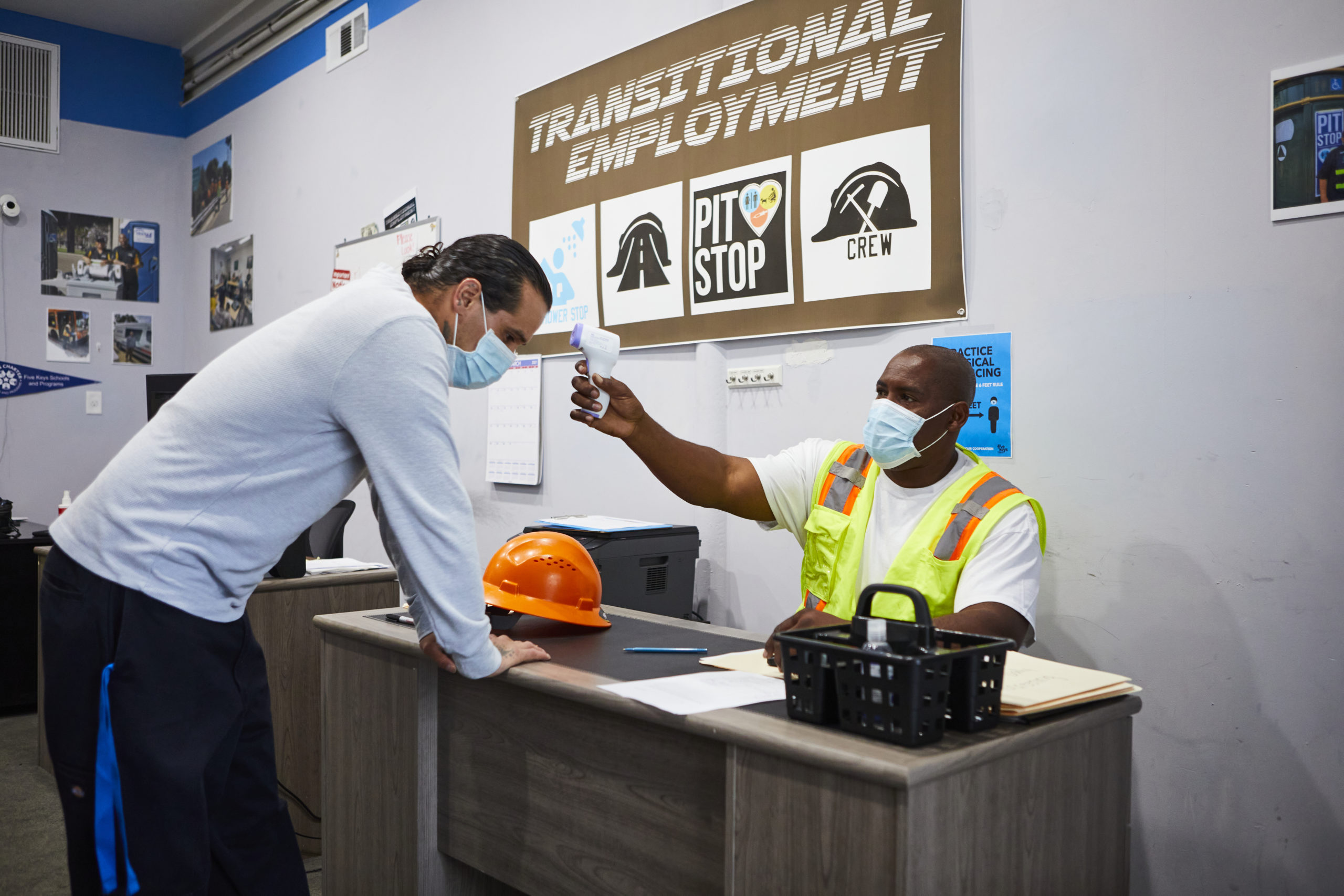
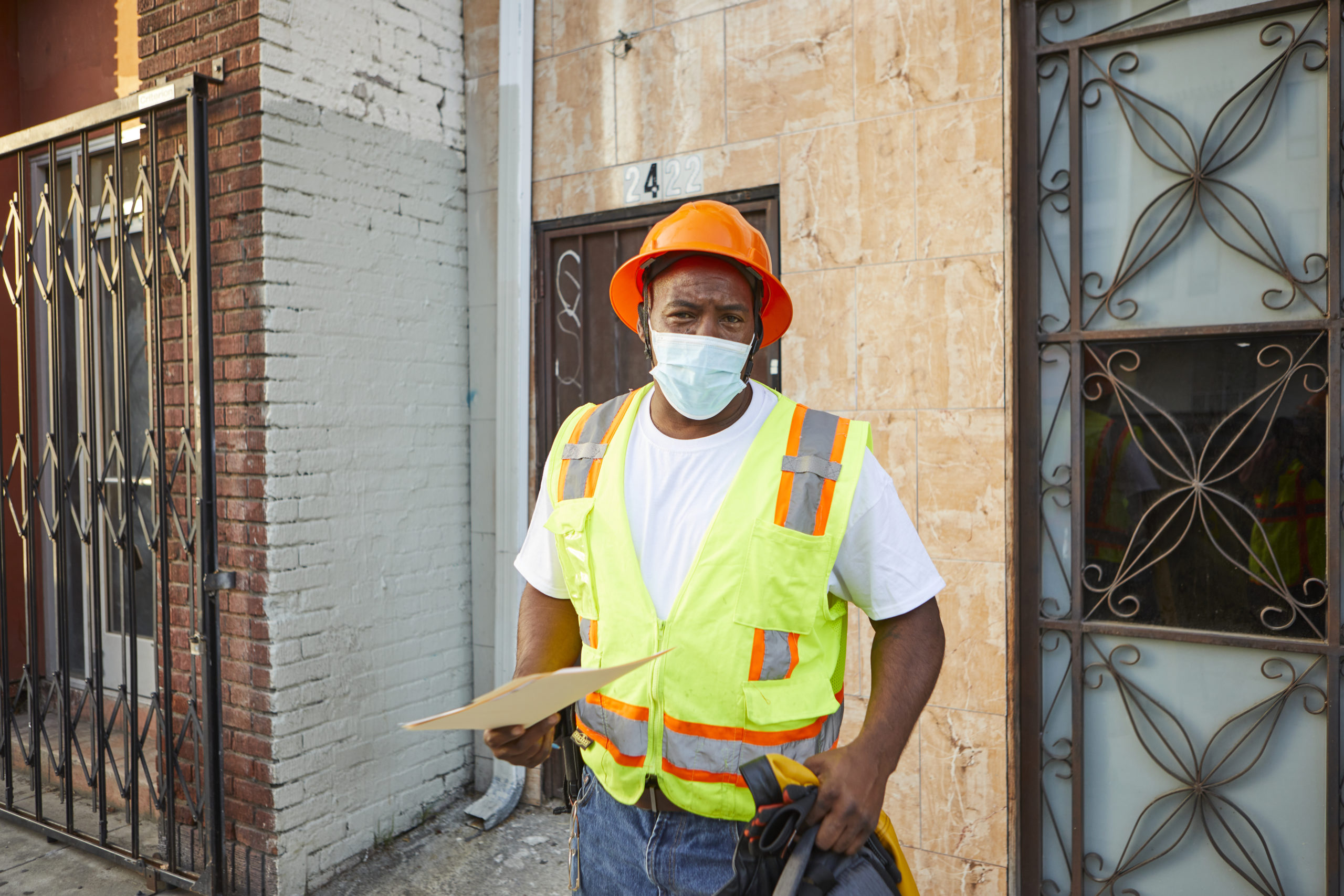

Robert works for Caltrans in Los Angeles, a job that the nonprofit Five Keys helped to place him in. Every morning, he checks his coworkers temperature to comply with COVID safety protocols before driving his team to their job sites in a Five Keys van. Photos by Nathalie Gordon.
RJ: How did the other protocols in the facility — like shutting down visitation and programming — how did that impact you?
Robert: Well, for me, I happened to be fortunate enough to be chairman of AA and AlAnon. So I understood how to cope with different things.
It goes to the individual. How do you prioritize your day? If you just sit in a cell, when you don’t have anything to do, you’re going to be bored. Negative thoughts are going to start coming into your head, you’re going to start acting on those negative thoughts. However, if you have — I was doing college work, so I had things to do to keep me occupied during that time. So for me, I needed more time, I would wake up early, and I would be like, “I’m trying to get this book read, I’m trying to get this done. I’m trying to write this essay, I’m trying to do this book report.” So for me, that’s how I utilized the time.
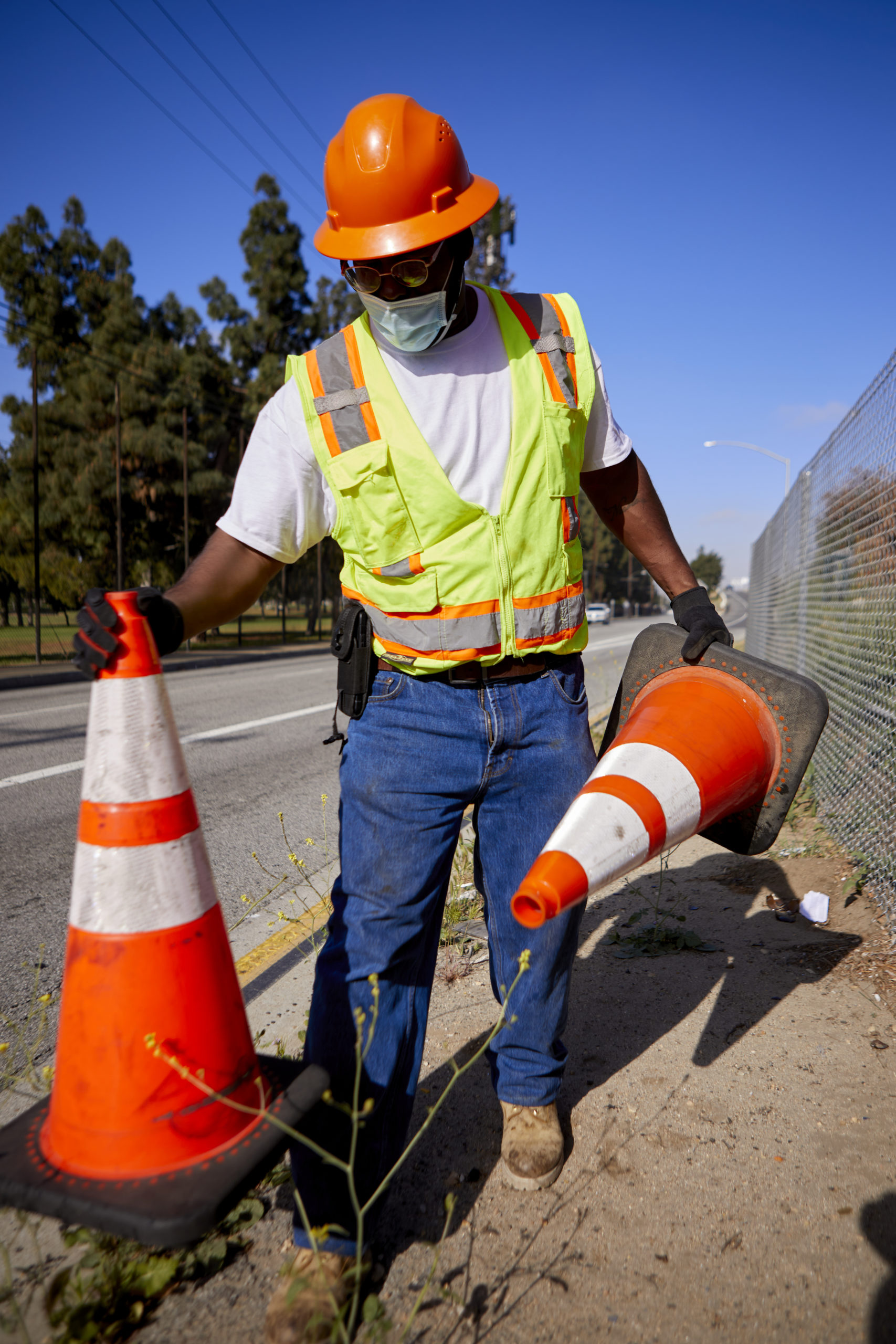

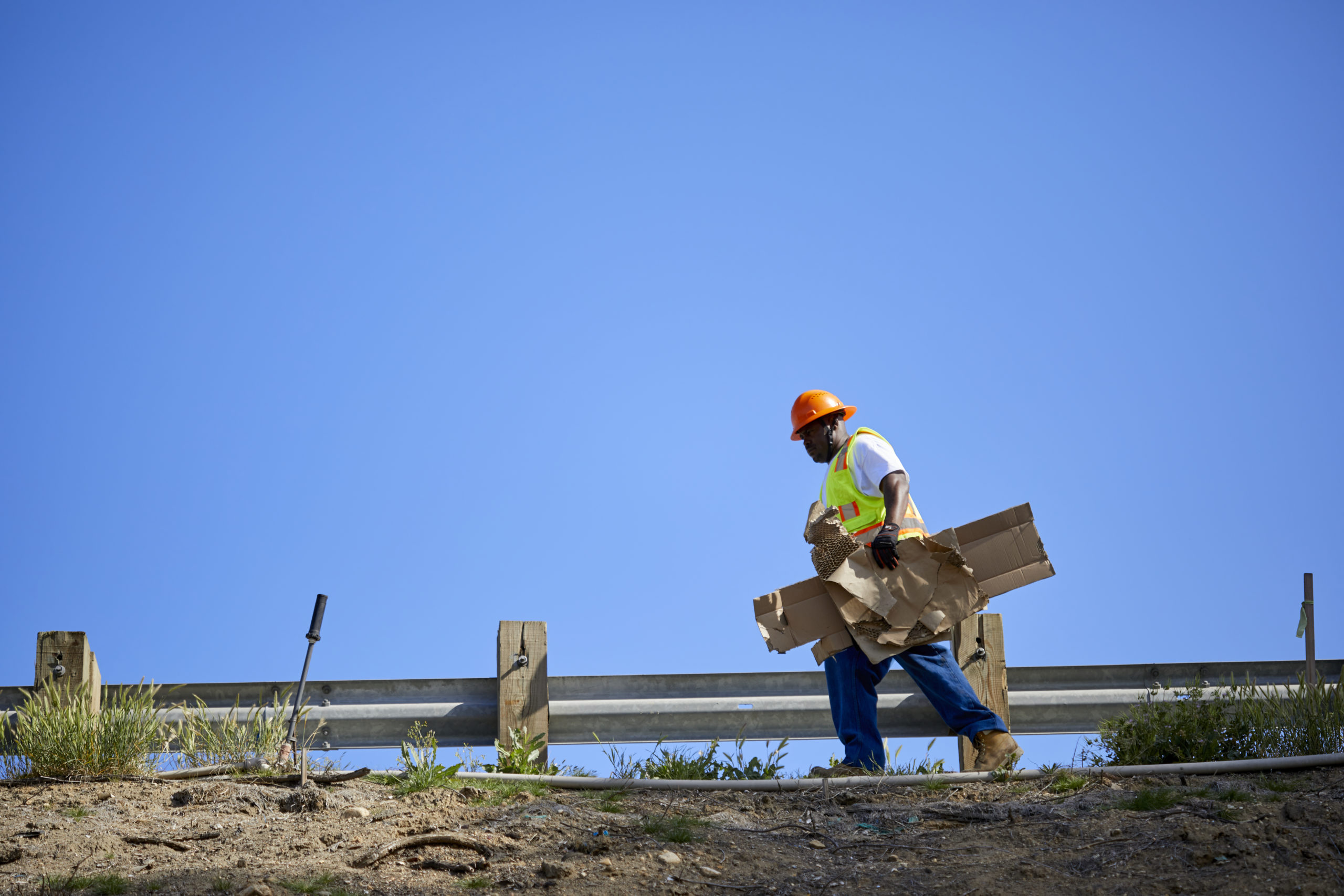
Robert and his team (co-worker Miguel is pictured here) spend their shifts driving out to multiple highways in Los Angeles county to maintain them safe and free of debris. Photos by Nathalie Gordon.
RJ: What are some things that you’re proud of yourself for?
Robert: I feel proud of myself that I’m able to hold this together, that I don’t act on some of the things that come up, like, why is this happening? Why is that happening? How could I be a better person? How could I be a better son? How can I be a better brother?
RJ: Who do you turn to or what are some strategies that you’ve used to support yourself over the last few months you’ve been home?
Robert: So I have a lot of good friends, a lot of good supporters. Many different people are in my life that make a major contribution to my life. I don’t know where I would be emotionally. I don’t know where I would be spiritually. I don’t know where I would be right mentally because they helped me.
Everything that I do is almost the first time I’ve done it, so having their support and help is wonderful. That’s what we need. We need people on the outside to support people on the inside once they come out. And I think if we can get people to sponsor people who don’t have anybody, when they come out, I think we have a better chance at rehabilitating people coming out of prison, like myself, and institutions and jails. I think that’s the biggest need.
Everyone on the inside is coming back to the outside, eventually, one day, right? So how do you want them to come back into the community? Are they going to be inviting? Or is it a, “I’m not going to give you a job” ? We have to believe in second chances. If we don’t believe in each other, then what do we have?
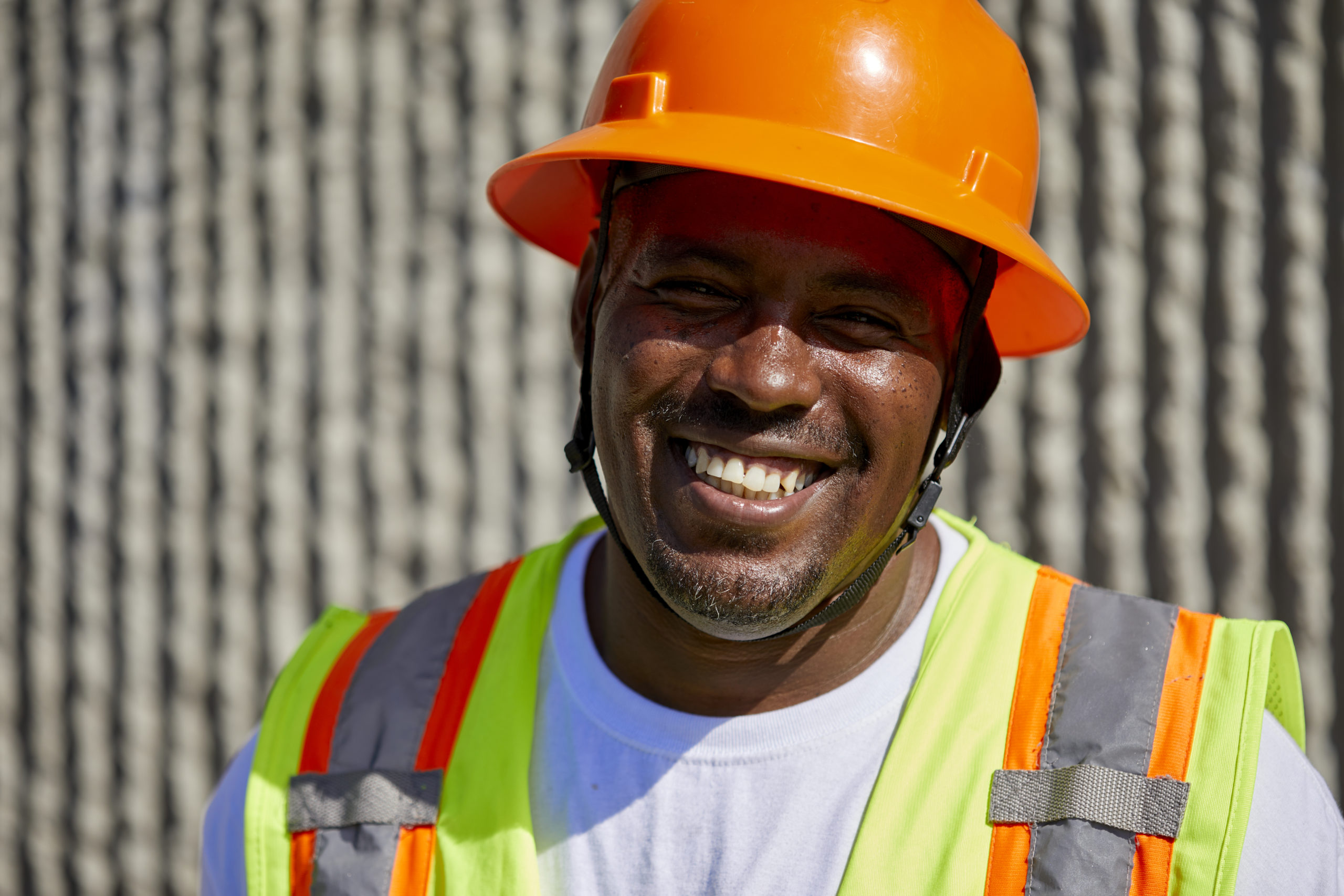
Robert is grateful for the people and organizations who’ve supported him in his reentry process, and believes everyone deserves a second chance and resources to build their lives upon release. Photo by Nathalie Gordon.
